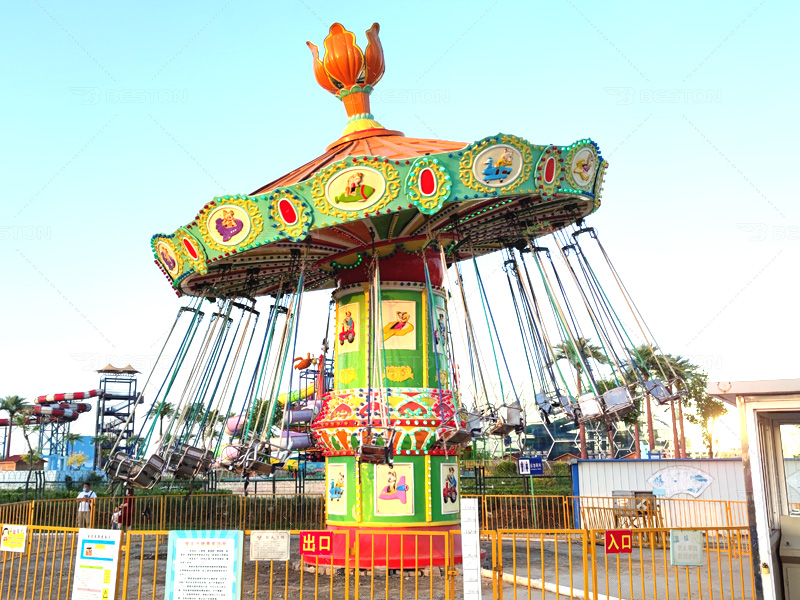Performing daily maintenance on the flying chair ride is essential to ensure its safe and efficient operation. Regular maintenance helps identify and address potential issues before they escalate, ensuring a smooth and enjoyable experience for riders. Additionally, paying attention to operational matters is crucial for the overall management and success of the ride. Here are some guidelines for daily maintenance and operational considerations.
Daily Maintenance
1. Visual Inspection
Start each day with a thorough visual inspection of the flying chair ride. Look for any signs of damage, loose or worn-out components, or abnormal wear and tear. Pay close attention to structural elements, seats, restraints, electrical connections, and safety mechanisms. If any issues are detected, address them promptly.
2. Lubrication
Proper lubrication is vital for the smooth functioning of moving parts. Follow the manufacturer’s guidelines regarding lubrication points and recommended lubricants. Apply lubricants as necessary to minimize friction, reduce wear, and ensure optimal performance. Regularly check for any signs of excessive friction or inadequate lubrication during operation.
3. Electrical Systems
Inspect the electrical systems, including wiring, connections, control panels, and switches. Look for any loose or damaged wires, faulty switches, or signs of overheating. Ensure that all electrical components are properly grounded and functioning correctly. If any electrical issues are identified, consult a qualified electrician for repairs.
4. Safety Checks
Verify the functionality of safety features, such as seat restraints, emergency stop buttons, and interlocking mechanisms. Test all safety systems to ensure they are in proper working order. If any safety concerns arise, address them immediately and restrict access to the ride until the issues are resolved.
5. Cleaning and Maintenance
Keep the flying chair ride clean and free from debris. Regularly remove any dirt, leaves, or other foreign objects that may accumulate on the ride or in its mechanisms. Clean seats, restraints, and any exposed surfaces with appropriate cleaning agents. Regularly inspect and maintain the ride’s structural components, including bolts, nuts, and supports.

Operational Matters
1. Staff Training
Ensure that all ride operators and attendants are properly trained in the safe operation of the flying chair ride. Train them on emergency procedures, rider safety protocols, and how to handle various operational scenarios. Regularly conduct refresher training sessions to keep staff up-to-date with the latest safety guidelines and operational procedures.
2. Queue Management
Efficient queue management is crucial to provide a smooth and organized experience for riders. Implement clear signage, barriers, and designated waiting areas to guide guests. Monitor the queue length and adjust ride operation accordingly to maintain a reasonable wait time. Properly trained staff should supervise the queue to maintain order and enforce safety rules.
3. Rider Safety Briefing
Before riders board the flying chair ride, ensure they receive a clear and concise safety briefing. Communicate the safety rules, including height restrictions, seating instructions, and behavior expectations. Emphasize the importance of following instructions and remaining seated throughout the ride. Encourage guests to report any discomfort or safety concerns to the ride attendants.
4. Operational Schedule
Establish an operational schedule for the flying chair ride based on demand and visitor flow. Consider factors such as peak hours, weather conditions, and maintenance requirements. Regularly review the schedule to optimize ride availability and minimize downtime for maintenance or repairs.
5. Incident Reporting and Documentation
Implement a standardized incident reporting procedure. In the event of any accidents, malfunctions, or safety-related incidents, ensure that staff members document the details accurately. Maintain a record of incidents and use the information to analyze trends, identify potential risks, and improve safety measures.
6. Regular Inspections and Audits
Conduct regular inspections and audits of the flying chair ride to ensure compliance with safety standards and regulations. Engage third-party inspectors if necessary to provide an unbiased assessment. Address any identified issues promptly and keep detailed records of inspections and maintenance activities.
By following these daily maintenance practices and focusing on operational matters, you can ensure the safe and efficient operation of your flying chair ride. Prioritize rider safety, engage well-trained staff, and establish robust maintenance procedures to create a positive and enjoyable experience for your visitors.Only in this way, you could build a profitable amusement park. Beston will help you to do the amusement park design and amusement park rides for sale. Contact us now!
